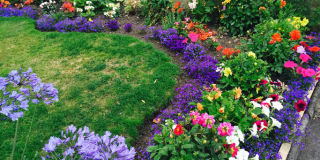Gardening in July: This is one of the most productive months in the garden, but there’s still time to plant and plenty to enjoy
Perennials
- Keep up with deadheading bedding plants, sweet peas and roses. The flowers on dahlias will need to be cut off once they’ve started to fade.
- Many of the traditional English cottage perennials such as lupins, delphiniums and geraniums are starting to look past their best now so cut them right back down and they’ll resprout. They may not flower again but they’ll look a lot better.

- Water and feed everything regularly, especially tomatoes, to avoid problems. Also tie them in to their canes and pinch out the side shoots if necessary.
- The last sowing of French beans and carrots can be done now. Transplant purple sprouting broccoli and winter leeks to their final position, or buy them as plugs from a garden center or nursery.
- Keep sowing seeds for salads, a few at a time, as well as autumn crop peas, turnips and spring cabbages.
- Keep an eye on apples and plums to make sure there are not too many on each stem and thin out if necessary – just three or four is enough.
- There should still be some strawberries ripening. Check there is enough straw under the plants to keep fruit off the soil. If you’ve been pegging down the strawberry runners, by now they should have formed enough roots to enable you to transplant them, either to pots to keep safe until they can be put in the ground, or straight into a new strawberry bed.
Harvest
- Strawberries and other soft fruit should be ripe and ready to collect now.
- Pick and freeze or dry herbs so they can be used later.
- A lot of the earlier-sown vegetables will be ready in July, for instance peas and broad beans, French and runner beans, globe artichokes, carrots and beetroot.
- Keep an eye on fruit; cherries, peaches, gooseberries, raspberries and early plums are really starting to ripen.
Watering
- This is something that’s easy to do, but easy to get wrong, and often the main problem is under watering. If you spray an area of planting for one minute and move on, the water is unlikely to have gone deeper than a few millimeters into the soil, so won’t have penetrated anywhere near the roots.
- You need to water like a rain cloud. One way to test this is to put a jam jar in among the plants you’re watering and stop when there’s about 2cm of water in the jar. That’s likely to take about 10-20 minutes on each area, which is understandably daunting. It’s one of the reasons why leaky hose systems, which deliver water to the soil via a porous hose and operate at the turn of a tap, are so appealing.
- It’s a good time to get rid of strongly growing perennial weeds such as ground elder and bindweed. Use a systemic weed killer such as glyphosate that will enter the weed through its leaves and should kill it off.
Roses
- July in rose-growing circles is known as the month for black spot. If you find it, remove the affected leaves and spray the plant with fungicide. The same goes for another fungus, mildew, which can also become a problem in July if the roses are stressed by having too much or too little water. Try to spray the fungicide early in the morning so you don’t affect any bees that might be buzzing around the plant. Finally don’t forget to deadhead the roses to keep them flowering.
Lawn
- Keep mowing the lawn if it’s not parched and, if it’s looking tired, July is the last opportunity to apply a summer fertilizer. If it’s dry you may need to water your lawn. Use a specialist lawn weed killer if necessary.
Hedges
- If you have a conifer hedge, especially a leylandii one, keep a close eye on it at this time of year for cypress aphids. It’s difficult to see the aphids themselves so look for brown patches in the hedge and a black sooty mold along the stem. If you find it, the best thing to do is prune out any brown shoots and spray affected areas with pesticide.
Deadheading bedding plants and border perennials is important to keep your displays looking fresh and tidy. Get more flowers in borders, containers and hanging baskets by adding a liquid feed once a week.
IF YOU ONLY DO ONE THING…
…Go into borders, lift leaves and have a look around. Often it’s not a good idea to go looking for problems, but in the garden it pays to have a rummage, as the fresh growth of the past months can hide and feed pests, and weeds can grow unseen under it.









